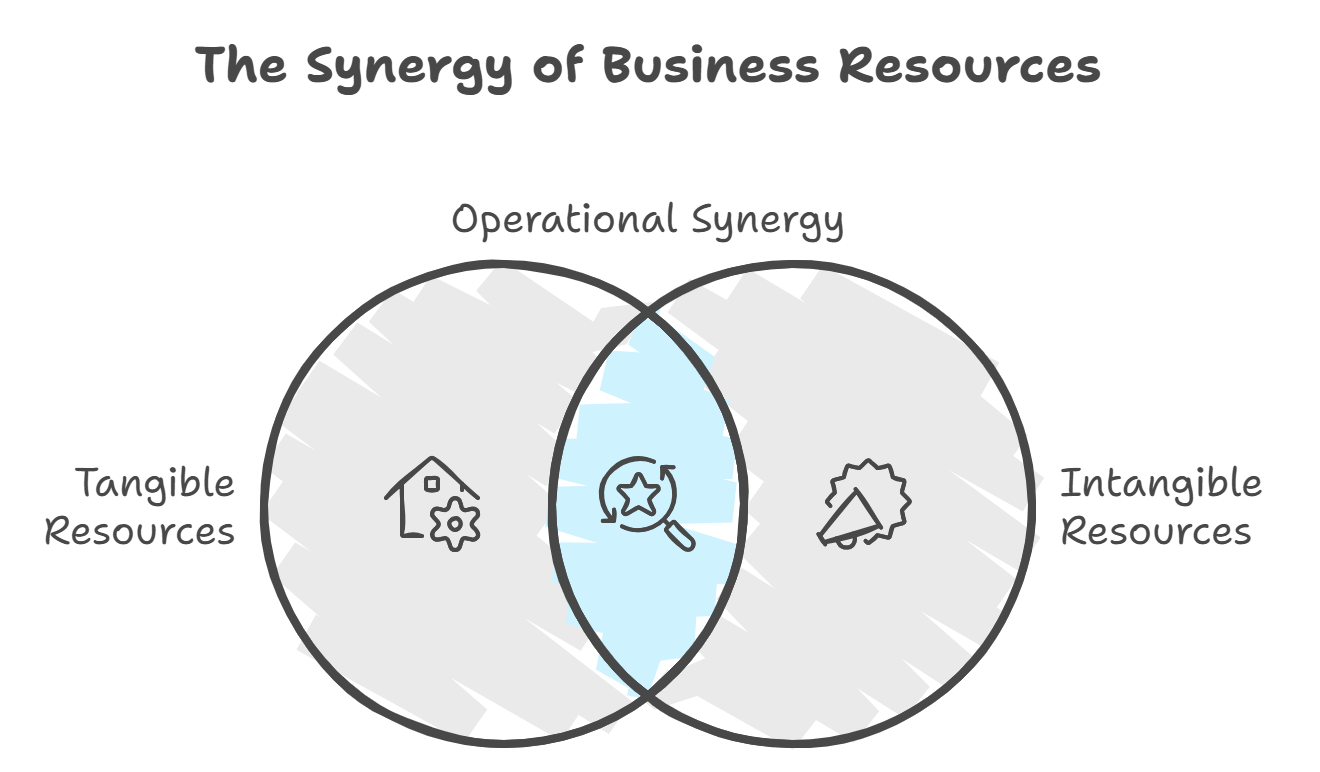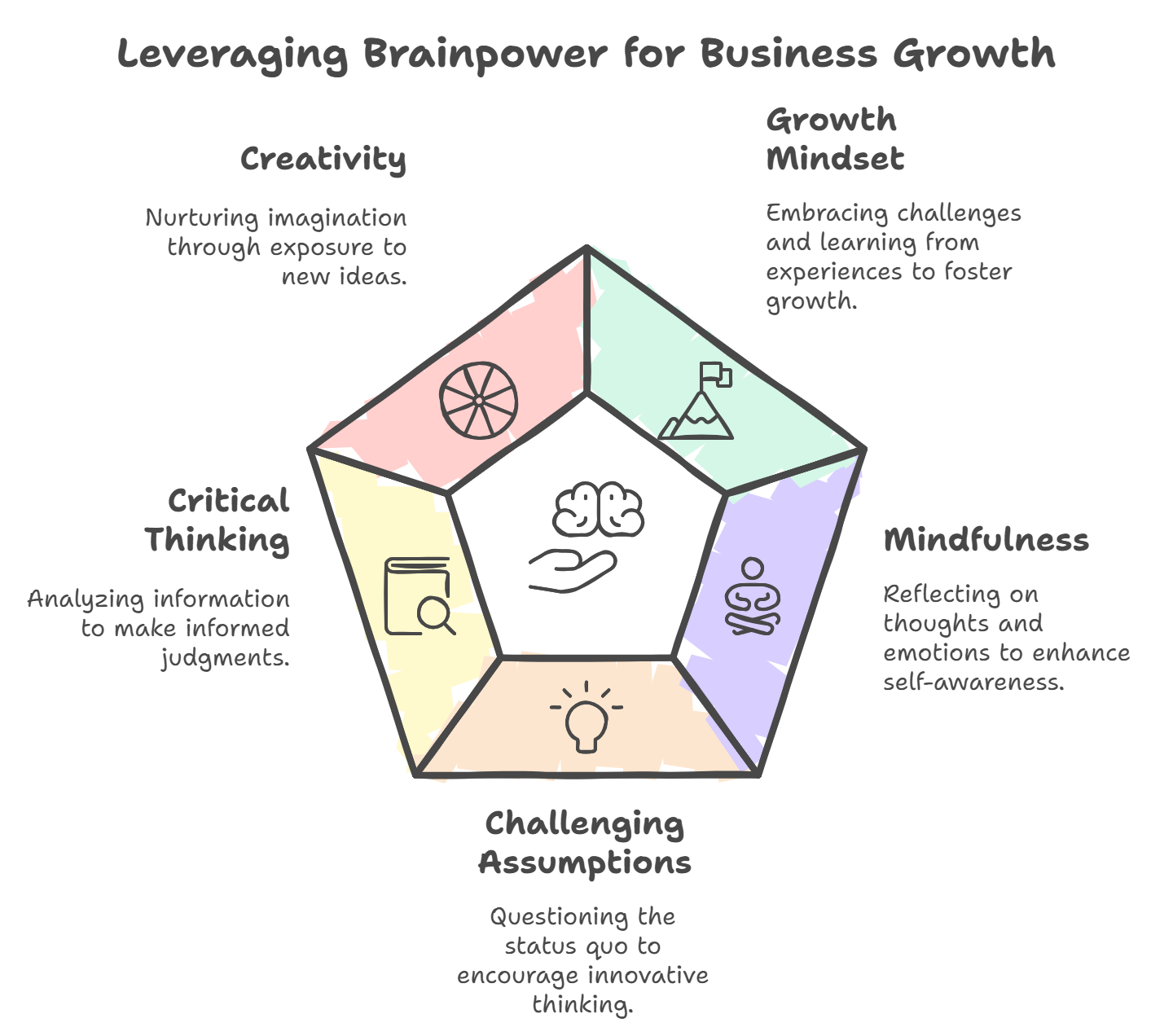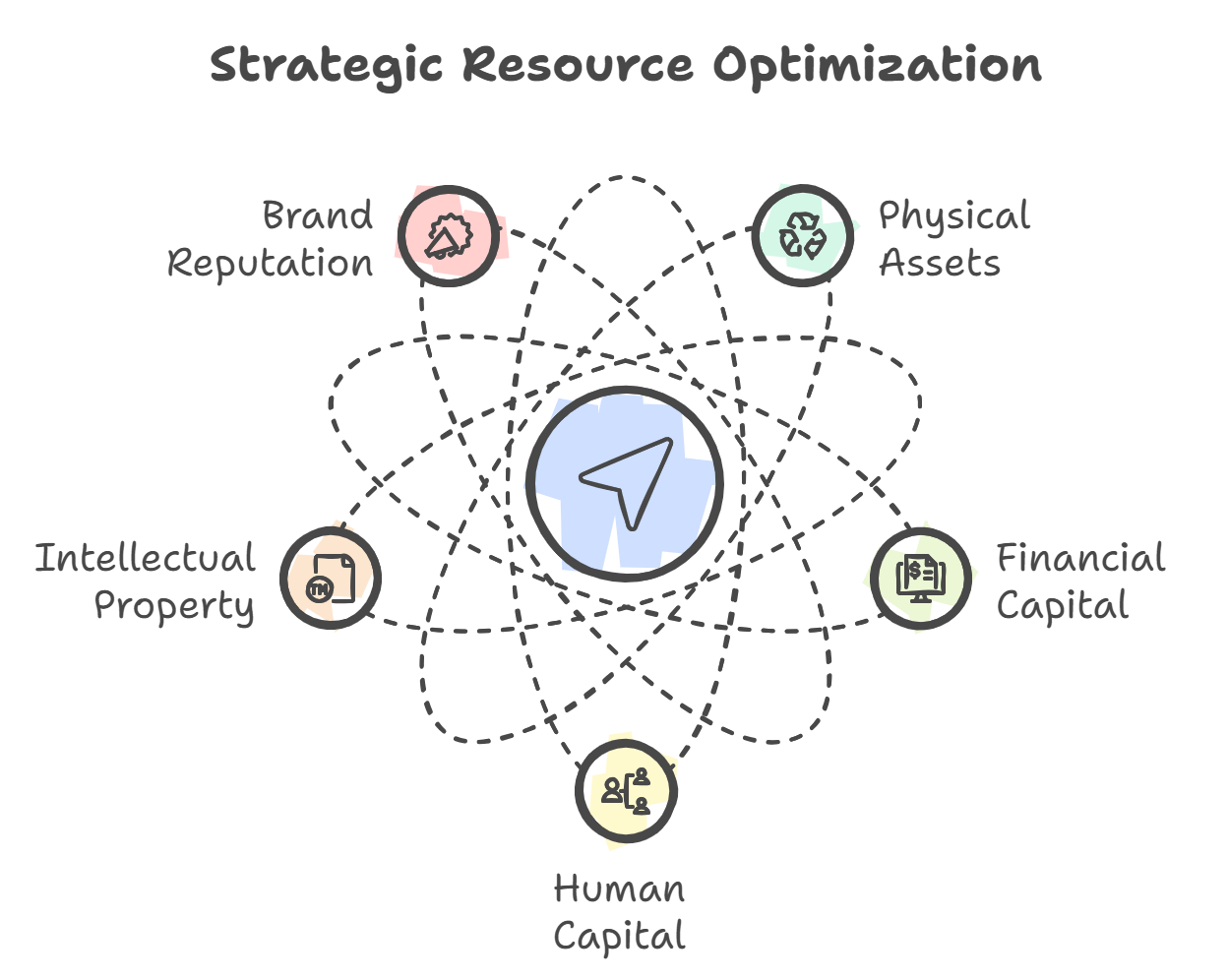Unlock Explosive Growth: The Untapped Power of Your Key Resources
Fueling Business Growth with What You Already Have
Stop wasting time, money, and energy. Discover how to leverage your existing resources for explosive business growth.
Ever feel like you’re running a business on a treadmill? You’re putting in the effort, sweating it out, but not really getting anywhere? You’re pumping money into marketing, hiring new staff, and even trying those “miracle” growth hacks you saw on LinkedIn (we’ve all been there!), but the needle just isn’t moving. The problem might not be what you’re adding to the mix, but what you’re failing to utilise effectively: your key resources.
Many entrepreneurs and SME owners fall into the trap of chasing shiny new objects, constantly seeking external solutions for growth. But what if I told you the key to unlocking your business’s true potential lies within the resources you already possess? It’s like having a treasure chest in your attic and spending all your time searching for gold dust in the backyard.
In this blog post, we’ll dive deep into the often-overlooked power of key resources. We’ll explore how to identify them, optimise their utilisation, and leverage them strategically to fuel sustainable business growth. Get ready to ditch the treadmill and embark on a journey of efficient, impactful growth.
The Untapped Power of Key Resources
Before we jump into the “how-to,” let’s get clear on what we mean by “key resources.” Think of them as the vital organs of your business – the essential elements that enable you to function, deliver value, and achieve your goals. They’re the foundation upon which your entire operation is built.
These resources come in two primary flavours:
- Tangible Resources: These are the things you can touch and feel (well, maybe not the bank balance after a rough month!). Think physical assets like your office space, equipment, inventory, and, of course, that lovely financial capital.
- Intangible Resources: These are the less visible but equally crucial assets. Your human capital (your team’s skills and experience), intellectual property (patents, trademarks, that killer secret sauce recipe), and brand reputation all fall under this category.

Now, here’s the kicker: most businesses, especially SMEs, fail to realise the full potential of these resources. They might have a talented team but lack the systems to utilise their skills effectively. Or they might have a fantastic product but fail to market it strategically. It’s like having a Ferrari and driving it like a golf cart – what a waste!
The Ultimate Resource: Unleashing the Power of Your Mind
We’ve talked about tangible resources, intangible resources, and even the wonders of technology. But let’s not forget the most powerful resource of all: your mind – the grey matter between your ears! The ultimate powerhouse of ideas, innovation, and strategic thinking.
Think of your mind as the control centre of your business. It’s the source of your creativity, your problem-solving abilities, and your strategic vision. It’s the engine that drives innovation, the compass that guides your decisions, and the architect that designs your future.
But here’s the thing: just like any other resource, your mind needs to be nurtured, trained, and optimised to reach its full potential. It’s like a muscle – the more you use it, the stronger it gets.
So, how can you leverage this ultimate resource to drive business growth? Here are a few ideas:
- Cultivate a growth mindset: Embrace challenges, learn from your mistakes, and constantly seek new knowledge and experiences.
- Practice mindfulness and self-awareness: Take time to reflect on your thoughts, emotions, and behaviours. Understand your strengths and weaknesses, and identify areas for improvement.
- Challenge your assumptions: Don’t be afraid to question the status quo and explore new perspectives. Break free from limiting beliefs and embrace innovative thinking.
- Develop your critical thinking skills: Sharpen your ability to analyse information, identify biases, and make sound judgments.
- Foster creativity and imagination: Nurture your creative spark through brainstorming sessions, experimentation, and exposure to new ideas and inspiration.
- Prioritise mental and physical well-being: Take care of your mind and body through exercise, healthy eating, and stress management techniques. A healthy mind is a productive mind.

“Your most valuable asset isn’t listed on your balance sheet. It’s the collective brainpower of your team, a dynamic force capable of generating exponential growth. Invest in it wisely, nurture it carefully, and watch as it compounds into a powerhouse of innovation, problem-solving, and market domination.”
Remember, your mind is not just a resource; it’s the ultimate tool for unlocking your business’s full potential.
Think of the ability to fully utilise your brainpower as the ultimate meta-skill – the one that amplifies and elevates all other resources and opportunities. It’s like having a superpower that allows you to see patterns others miss, connect dots others don’t even notice, and unlock potential that remains hidden to the untrained mind.
This meta-skill isn’t about raw intelligence or IQ; it’s about harnessing the full spectrum of your cognitive abilities – your creativity, critical thinking, emotional intelligence, and intuition. It’s about developing the mental agility to adapt to change, the focus to cut through distractions, and the resilience to bounce back from setbacks.
When you master this meta-skill, you transform from a mere manager of resources to a conductor of an orchestra. You can orchestrate your tangible and intangible assets, human capital, and even your technological tools with finesse and precision that others can only dream of.
Imagine having the clarity to identify the most impactful opportunities, the wisdom to make sound decisions under pressure, and the vision to navigate your business through uncertainty. This is the power of a fully utilised mind – a strategic resource and a competitive powerhouse that can turn challenges into triumphs and dreams into reality.
The Symptoms of Mismanaged Resources
Now, let’s play doctor for a moment. Just like a physical ailment manifests through symptoms, mismanaged resources also exhibit telltale signs. Ignoring these signs can be detrimental to your business’s health.
The “Leaky Bucket” Syndrome
Imagine pouring water into a bucket with holes. No matter how much water you add, it’ll never fill up. That’s what happens when you’re wasting resources. This “leakage” can take many forms:
- Redundant processes: Are you stuck in a maze of unnecessary approvals and paperwork? Time is a precious resource, and convoluted processes are like tiny holes draining it away.
- Inefficient workflows: Do your teams work in silos, duplicating efforts and creating bottlenecks? It’s like having multiple departments trying to fill the same bucket but tripping over each other in the process.
- Underutilised assets: Is that expensive equipment gathering dust in the corner? Or are you paying for software licenses that nobody uses? Every idle asset is a hole in your resource bucket.
The “Confused Compass” Effect
Misaligned resources can leave your customers and employees feeling lost and disoriented.
- Conflicting messages: Is your marketing team promising features that your product team hasn’t even started building? Or are your sales reps giving discounts that your finance department isn’t aware of? This creates confusion and erodes trust.
- Poor customer experience: Do your customers struggle to navigate your website, reach customer support, or get their issues resolved? This can lead to frustration and ultimately drive them away.
- Lack of employee engagement: Are your employees unclear about their roles and responsibilities? Do they feel their skills are being utilised effectively? This can lead to demotivation and decreased productivity.
The “Overworked Engine” Dilemma
Pushing your resources beyond their capacity can lead to burnout and breakdown.
- Employee stress and overwork: Are your employees constantly working long hours, juggling multiple tasks, and feeling overwhelmed? This can lead to stress, decreased morale, and even health issues.
- Compromised quality: When resources are stretched thin, quality often suffers. This can cause subpar products, delayed deliveries, and increased customer complaints.
- Increased errors and accidents: A stressed and overworked workforce is more prone to making mistakes, which can lead to costly errors and even safety hazards.
The Price of Inaction: Consequences of Poor Resource Management
Okay, so we’ve diagnosed the symptoms. Now, let’s get real about the consequences. Ignoring these warning signs can lead to a downward spiral, impacting your business’s growth, profitability, and even its survival.
Stagnation and Lack of Growth
Remember that treadmill analogy? Well, mismanaged resources keep you stuck in that same spot, no matter how fast you run. You might be generating revenue, but you’re not scaling, expanding, or reaching your full potential. It’s like trying to climb a mountain with a backpack full of rocks – you’re carrying unnecessary weight that’s holding you back.
High Customer and Employee Churn Rates
Confused customers and unhappy employees? They’ll eventually head for the exit. High churn rates are a major red flag, indicating that your resources aren’t aligned to deliver a positive experience for both your internal and external stakeholders. It’s like having a revolving door at your entrance – people are constantly coming and going, and you’re losing valuable time and money trying to replace them.
Loss of Competitive Advantage
In today’s cutthroat business landscape, every advantage counts. Failing to leverage your key resources effectively can put you at a significant disadvantage. Your competitors might be optimising their processes, investing in their people, and building stronger brands while you’re stuck playing catch-up. It’s like bringing a knife to a gunfight – you’re not equipped to compete effectively.
Financial Instability and Potential Business Failure
Resource mismanagement can drain your finances faster than you can say “cash flow.” Wasted time, duplicated efforts, and lost opportunities all contribute to a financial hemorrhage that can ultimately lead to business failure. It’s like having a hole in your pocket – your money is constantly slipping away, and you’re left wondering where it all went.
From Chaos to Control: A Strategic Approach to Resource Allocation
Alright, enough with the scary stories. Let’s shift gears and talk about turning this ship. The good news is that you can control your resources and steer your business towards growth and success. It all starts with a strategic approach to resource allocation.
Resource Inventory: Know What You Have
You can’t manage what you don’t know. It’s time to take stock of your resources, both tangible and intangible. Think of it as a treasure hunt within your own business. Dust off those forgotten assets, identify hidden talents and uncover untapped potential.
- Physical assets: Conduct a thorough inventory of your equipment, inventory, and facilities. Are they being utilised effectively? Can any be repurposed or sold off?
- Financial capital: Analyze your cash flow, revenue streams, and expenses. Where is your money going? Are there any areas where you can reduce costs or improve efficiency?
- Human capital: Assess the skills, experience, and potential of your team. Are they in the right roles? Do they have the training and support they need to excel?
- Intellectual property: Identify your patents, trademarks, copyrights, and trade secrets. Are they adequately protected? How can you leverage them to create a competitive advantage?
- Brand reputation: Evaluate your brand image, customer perception, and online presence. What are your strengths and weaknesses? How can you build a stronger, more recognisable brand?

Prioritise and Align: Connect Resources with Business Goals
Resources are like ingredients in a recipe. You need the right combination in the right amounts to create a delicious dish (or in this case, a successful business). This means prioritising your resources based on your strategic goals.
- Define your objectives: What are you trying to achieve? Increased sales? Market expansion? New product development? Your goals will dictate how you allocate your resources.
- Identify key performance indicators (KPIs): How will you measure success? Establish clear metrics to track progress and identify areas for improvement.
- Align resources with priorities: Ensure your resources are deployed in a way that supports your goals and KPIs. Don’t spread yourself too thin – focus on the areas that will have the biggest impact.
Optimize and Streamline: Eliminate Waste and Maximize Efficiency
Think of your business as a well-oiled machine. Every part needs to work smoothly and efficiently to achieve optimal performance. This requires streamlining processes, eliminating waste, and maximizing productivity.
- Identify bottlenecks: Where are workflow inefficiencies? Are there any unnecessary steps or delays that can be eliminated?
- Automate tasks: Can technology help you automate repetitive tasks and free up your team’s time for more strategic work?
- Improve communication and collaboration: Foster a culture of open communication and collaboration to ensure that everyone is on the same page and working towards the same goals.
Unlocking Growth: How to Leverage Your Key Resources
Alright, let’s get down to brass tacks. We’ve identified our resources, prioritised them, and streamlined our operations. Now, it’s time to unleash their full potential and propel our business towards growth.
Invest in Your Human Capital: Training, Development, and Empowerment
Your employees are your most valuable asset (yes, even more valuable than that fancy espresso machine in the breakroom!). Investing in their growth is investing in growing your business.
- Provide ongoing training and development: Equip your team with the skills and knowledge they need to excel in their roles and adapt to changing market demands. Think workshops, online courses, mentorship programs, and even good old-fashioned books!
- Create a culture of learning: Encourage continuous learning and professional development. Foster an environment where employees feel comfortable asking questions, seeking feedback, and sharing knowledge.
- Empower your employees: Give your team the autonomy and responsibility to make decisions and contribute their ideas. This not only boosts morale but also unlocks their creative potential and problem-solving skills.
Maximise the Use of Technology: Automation, Data Analytics, and Process Improvement
Technology is not just a shiny toy; it’s a powerful tool that can help you optimise your resources and boost efficiency.
- Embrace automation: Automate repetitive tasks like data entry, invoicing, and social media scheduling. This frees up your team’s time for more strategic work and reduces the risk of human error.
- Leverage data analytics: Gather customer data, operations, and market trends. Use this data to make informed decisions, identify areas for improvement, and personalise your offerings.
- Streamline your processes: Use technology to optimise workflows, eliminate bottlenecks, and improve communication. Think project management software, CRM systems, and cloud-based collaboration tools.
Build a Strong Brand Reputation: Customer Experience, Marketing, and Public Relations
Your brand is more than just a logo; it’s people’s perception of your business. A strong brand reputation can attract customers, retain talent, and give you a competitive edge.
- Focus on customer experience: Provide exceptional customer service, build relationships, and go the extra mile to exceed expectations. Happy customers are your best brand ambassadors.
- Develop a compelling brand story: Craft a narrative that resonates with your target audience and communicates your values, mission, and unique selling proposition.
- Utilise various marketing channels: Reach your target audience through a mix of online and offline channels. Think social media, content marketing, email marketing, public relations, and even good old-fashioned networking.
Turning the Tide: Action Plan for Resource Optimization
Alright, let’s translate all this knowledge into action. Here’s a practical action plan to help you optimise your resources and set your business on the path to sustainable growth.
Conduct a Comprehensive Resource Audit
It’s time to roll up your sleeves and get your hands dirty. Conduct a thorough audit of all your resources, leaving no stone unturned. This includes:
- Identifying and documenting all your resources: Create a detailed inventory of your tangible and intangible assets.
- Analysing resource utilisation: Assess how effectively each resource is being used.
- Identifying areas of waste and inefficiency: Pinpoint any bottlenecks, redundancies, or underutilised assets.
Develop a Clear Resource Allocation Strategy
Once you have a clear picture of your resources, it’s time to create a strategic plan for their allocation. This involves:
- Setting clear objectives and KPIs: Define what you want to achieve and how you will measure success.
- Prioritising resources based on strategic goals: Allocate resources to the areas that will have the biggest impact on your business growth.
- Creating a budget and timeline: Establish a financial framework and timeline for your resource allocation plan.
Implement Performance Monitoring Systems
You can’t improve what you don’t measure. Implement systems to track your progress, identify areas for improvement, and ensure that your resources are being used effectively.
- Track key metrics: Monitor your KPIs and other relevant metrics to assess the effectiveness of your resource allocation strategy.
- Regularly review and analyse data: Use data analytics to identify trends, patterns, and areas for optimisation.
- Make adjustments as needed: Be flexible and adapt your strategy based on the data and feedback you receive.
Foster a Culture of Resource Consciousness
Resource optimisation is not a one-time project; it’s an ongoing process that requires a shift in mindset. Foster a culture of resource consciousness within your organisation by:
- Educating your team: Ensure everyone understands the importance of resource optimisation and their role in the process.
- Encouraging feedback and suggestions: Create an environment where employees feel comfortable sharing ideas for improvement.
- Celebrating successes: Recognize and reward employees who contribute to resource optimisation efforts.
The Final Verdict (or simply “Do-Something-Now”)
Leveraging your key resources is not just a smart business move; it’s necessary for survival and growth in today’s competitive landscape. In the game of cents and percentages, strategic positions and competitive moves, identifying, optimising, and strategically allocating your resources can unlock the business’s potential, help achieve goals, and create a sustainable and prosperous future.
So, ditch the “more is always better” mentality and embrace the power of what you already have. Remember, it’s not about having all the resources in the world; it’s about making the most of the ones you do.
Now, go forth and conquer!
FAQs
- What’s the biggest mistake businesses make when it comes to resource management?
One of the biggest mistakes is failing to recognise the value of their intangible resources, particularly their human capital. Investing in employee training, development, and empowerment can yield significant returns in terms of productivity, innovation, and employee retention.
- How can I identify waste areas in my business?
Start by conducting a thorough resource audit. Analyse your processes, workflows, and asset utilisation to identify any bottlenecks, redundancies, or underutilised resources. Don’t be afraid to ask your employees for feedback – they often have valuable insights into areas for improvement.
- What tools and technologies can help me optimise my resources?
There are a plethora of tools, from project management software and CRM systems to automation tools and data analytics platforms. Choose what best fits your needs and budget. Don’t be afraid to experiment and try new things – you might be surprised at the results!

